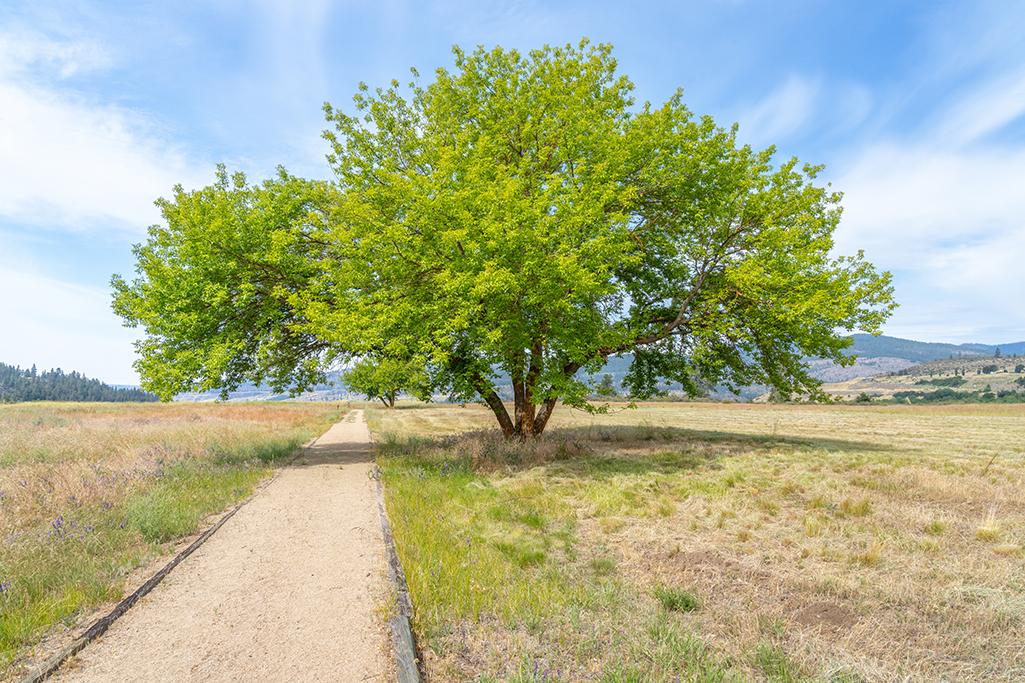
Box elder tree and the trail around Fort Spokane's parade grounds, Lake Roosevelt National Recreation Area / Rebecca Latson
Happy New Year, Travelers!
For my first photo article of 2025, I’m continuing with a tradition begun back in 2015 (wow, has it been 10 years?), with the naming of my 11 favorite images captured in 2024. Why am I choosing 11 shots instead of the 10 I’ve listed in past years? Because I had plenty to choose from, since 2024 was a busy travel year for me. I visited Great Sand Dunes National Park and Preserve in Colorado, Mount Rainier National Park and Lake Roosevelt National Recreation Area in Washington State, Badlands National Park, Wind Cave National Park, Jewel Cave National Monument, and Minuteman Missile National Historic Site in South Dakota, and Yellowstone National Park in Wyoming/Montana/Idaho.
Heck, choosing 11 shots from the thousands of images I captured was not that easy. Nevertheless, here for your viewing pleasure, in no order, are my favorites from 2024. You’ll see my choices, why I chose them, and the story behind each one (there’s always a story to every photo captured), including location and technique/settings.
Tree And Trail Around Fort Spokane, Lake Roosevelt National Recreation Area (Washington State)
I like history, so one early summer day, I traveled to Fort Spokane, located at the southeastern edge of this national recreation area. Box elder trees grow within this fort’s borders, particularly around the parade grounds. The box elder in this image was particularly lovely and you can see all its trunks. Box elder was historically cultivated around Fort Spokane but fort inhabitants attempted to “train” the trees to grow from single, rather than multiple trunks. It didn’t always work.
Anyway, I liked the composition. The entire image felt pleasing to the eye and the trail led the viewer from the photo’s foreground to the tree (middle ground) and on toward the background.
The photo was captured handheld during a ranger-led tour of the fort’s grounds. The bright, sunny day and camera settings (ISO 400, f-13, shutter speed 1/100) allowed for a clear shot without any camera blur.
Sunrise At Burns Basin Overlook, Badlands National Park (South Dakota)

Sunrise at Burns Basin Overlook, Badlands National Park / Rebecca Latson
As a morning person, I find it much easier to photograph sunrises. I arrived at Badlands the previous day and drove the loop road for a little locational recon. The park map aided in sunrise and sunset choices. Burns Basin Overlook proved perfect for both.
Arriving long before sunrise, I stood behind the tripod, hands in pockets from a chill wind (it’s always windy in this national park) and listened to the distant yips of a coyote pack. Eventually, the sun began its creep above the horizon behind and to the side of me, initially touching just the tips of the badlands formations with golden light before ultimately bathing the entire scene in bright light.
A tripod allowed use of a longer shutter speed (1/40) with a much smaller aperture (f-9) and a lower ISO (160) to minimize noise (graininess) in the composition.
FYI, for the most part, I use a tripod, even though there are times when I feel you don’t really need to.
Sunset Alpenglow And A Full Moon At Panorama Point, Badlands National Park (South Dakota)

Sunset alpenglow and a full moon at Panorama Point, Badlands National Park / Rebecca Latson
I’d first arrived in the park around noon, with its harsh light eliminating all shadows and depth. I captured a few images, drove the road for a little reconnaissance, checked into my Cedar Pass Lodge cabin, then went back out to attempt some sunset compositions. I drove all the way back toward the park’s Pinnacles Entrance to photograph at Pinnacles Overlook. Not totally satisfied with the results, I stopped at Ancient Hunters Overlook, then decided I was tired after driving some six hours from Billings, Montana to Badlands that day. Along the route back to my cabin, I noticed the full moon. On a whim, I stopped off at Panorama Point. The sunset alpenglow remained over these colorful badlands formations while the full moon hung against an indigo-blue sky.
I used a tripod for this image, ISO 160, f-13 aperture, and shutter speed 6 seconds. Full disclosure: the f-13 was a “fat-finger” accident, but it worked. You see, I wanted to capture that waning alpenglow while keeping everything else darkened and preventing overexposure of the moonlight.
Note: The aperture is the opening between lens and camera sensor. Measured in f-stops, your lens will usually have a ring with these f-stop numbers. Small apertures mean large f-stop numbers, and large apertures mean very small f-stop numbers. So, an aperture of f-16 means the opening between lens and camera sensor is very small and lets in very little light, while f-1.8 means the opening is very large, allowing in the maximum amount of light for that lens. Large apertures are usually applied for starry night imagery.
Resting Bison Face (RBF), Wind Cave National Park (South Dakota)
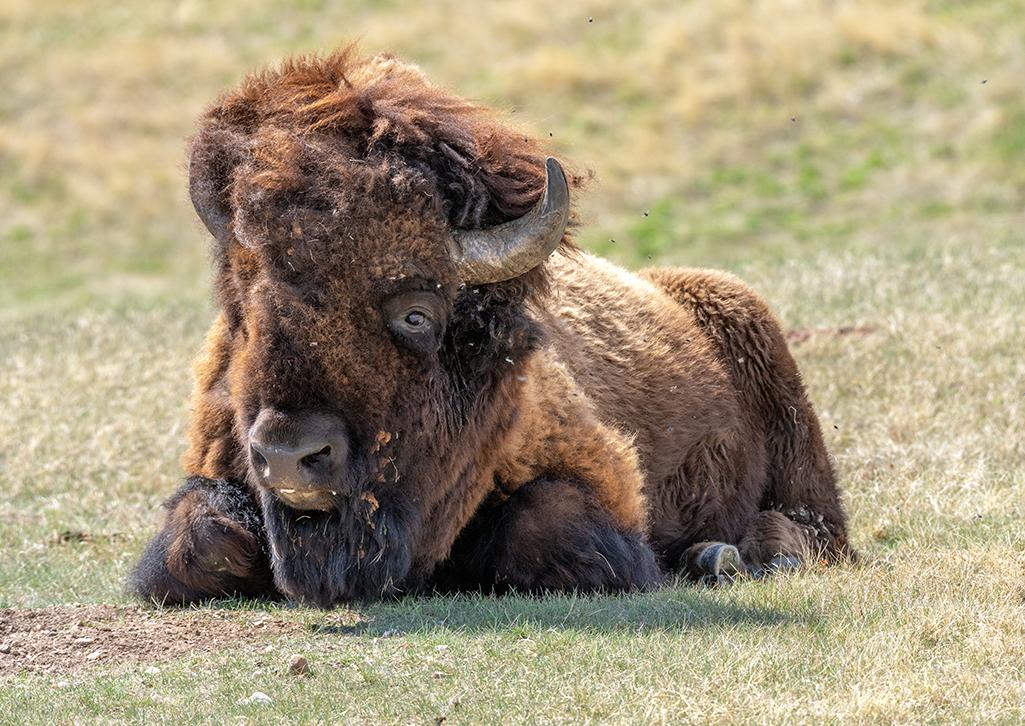
Resting bison face, Wind Cave National Park / Rebecca Latson
Hands down, bison are my favorite land mammal, and this national park showcases these wooly behemoths. I captured more images of bison at Wind Cave than at Badlands or even Yellowstone National Park. And by capture, I mean using a 200-600mm lens I rented for a fraction of the purchase price.
You can see the bison’s coat, with its different layers and fur textures, along with every detail of its face, including the little flies buzzing around it. Telephoto lenses and telephoto settings are wonderful things, allowing you to get up close without causing anxiety to the wildlife.
For wildlife action shots, a high ISO, fast shutter speed, and fast camera are necessary. Well, maybe a “fast” camera is not necessary, but it’s nice. What do I mean by a “fast” camera? A fast camera is one that has a high fps (frames per second) rate. This can range from 20 fps to 30+ fps when using the “burst method.” What is that? The burst method means you are holding your finger (or wireless/corded shutter release) down on the camera shutter button for several successive “clicks.” Out of all those shots will be at least one sharp, clear image of that wildlife.
Tip: the higher you set your ISO, the faster you can set your shutter speed. This bison was resting, so my ISO was just 400. Shutter speed was 1/250 and aperture was f-11 (it was very sunny that day).
Pronghorn, Wind Cave National Park (South Dakota)
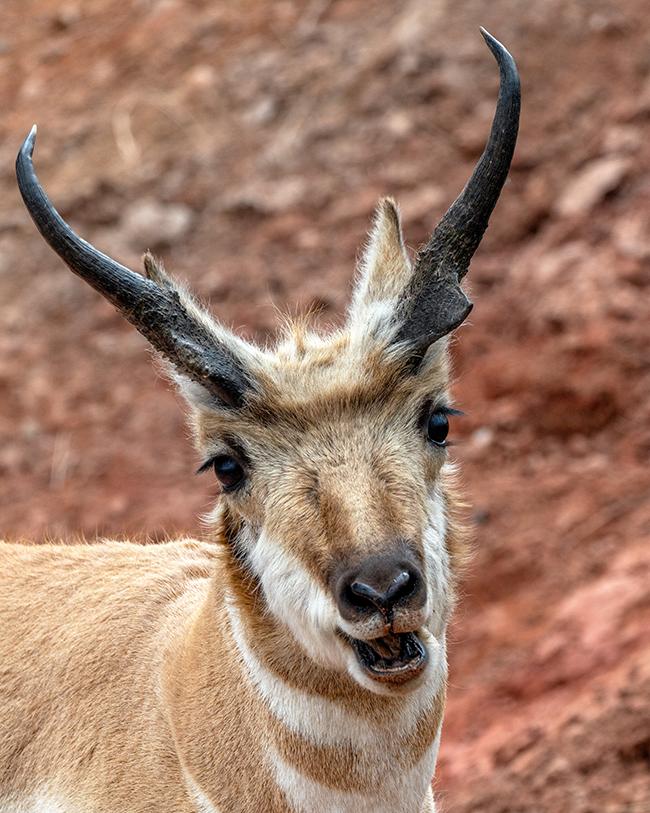
Pronghorn, Wind Cave National Park / Rebecca Latson
While driving from the Wind Cave visitor center back to the park entrance, I noticed out of the corner of my eye a furry butt sticking up from a depression alongside the road. My first thought was that furry butt might belong to an abandoned or lost dog, since pets must always be on a leash above ground in this national park.
Returning to the spot, I hopped out to discover a pronghorn placidly grazing within the depression. Capitalizing upon this chance encounter (all because I was worried it might be a lost or abandoned dog), I withdrew my tripod and telephoto lens for some close-ups.
Pronghorn fun fact: Often called pronghorn antelope, they are not antelope.
According to the National Park Service:
Pronghorns are found in North America and nowhere else in the world. They have roamed the plains and deserts unchanged for over a million years. Some call them antelope because they resemble African antelope, although the two are not closely related. They are the only surviving member of their family, Antilocapridae. The pronghorn’s closest living relatives are the giraffe and okapi.
“Jump-Yip,” Wind Cave National Park (South Dakota)

Jump-yip, Wind Cave National Park / Rebecca Latson
As you can tell by now, I captured the most wildlife shots at this national park. Black-tailed prairie dogs are adorable and fun to watch. Among other things, they have an interesting behavior scientists call “jump-yip.” After studying these little rodents related to the squirrel family, researchers concluded that this jump-yip “weee-ooo” activity is like “the wave” you see at sporting events. Except these prairie dogs are serious - the whole point of jump-yipping is for one prairie dog to assess the alertness and responsiveness of his or her associates. If others are highly alert, it means they will repeat the original jump-yip pattern, which in turn means its OK to continue foraging since others have their back, so to speak. However, if the others don’t follow through with “the wave,” the jump-yipper needs to proceed a little more warily.
I sat in my vehicle in the parking lot next to a prairie dog “town,” watching these little guys go about their business. My telephoto lens was sticking out the open window. It took several successive shots, because this jump-yip behavior is totally unpredictable. You must keep an eye on the prairie dog that originated the jump-yip to see if he/she would do it again, then be quick with the shutter button.
For this shot, my ISO was 1000, f-6.3, shutter speed 1/400. Under any other circumstance, a high ISO would mean blowing out (overexposing) the entire composition. But a fast shutter speed and a somewhat small aperture mitigate that overexposure to allow for a sharp shot of wildlife action.
Just After Sunrise At West Thumb Geyser Basin, Yellowstone National Park (WY/MT/ID)

Just after sunrise at West Thumb Geyser Basin, Yellowstone National Park / Rebecca Latson
I’ve traveled to Yellowstone three different times, but during each visit, I never thought to visit West Thumb. I made it a mission to do so with this 2024 summer trip, but the afternoon I arrived, nary a single parking space was available. This proved lucky for me. Had I explored this geyser basin that afternoon, I might not have returned the following morning, and that would have been my loss.
The following day, I arrived a little after sunrise and had the whole place to myself for a bit. The angle of that brilliant golden sunlight on the hydrothermal features created interesting shadows and accentuated the steam rising from the hot springs.
I handheld the camera for this image. That globe of sun was so bright and blinding, I knew I needed to adjust my settings to not blow out the sun too much. ISO was 160, f-8 aperture, and shutter speed 1/100. When your apertures and shutter speeds reach similar numbers, it’s a safe bet you’ll capture at least one shot free of camera shake blur when handholding and using the burst method.
Lingering Aurora, Mount Rainier National Park (Washington State)

Lingering aurora light, Mount Rainier National Park / Rebecca Latson
I’d been perusing Facebook posts of photographers capturing Aurora Borealis shots in parks much further south than one would expect for the Northern Lights. It never crossed my mind I might be able to capture faint pink aurora ripples during my mid-August hike at Mount Rainier. I was simply attempting an early-morning, starry sky shot. Imagine my delight when I saw the aurora in the image during editing.
Here's the thing about photographing auroras so far down south: our eyes don’t see so well in the dark and they can’t always pick up on faint aurora light. Cameras can pick up that light, but you need a long shutter speed and a wide-open aperture for the camera to pick up the existing light. High ISOs are a help too, but you run the risk of a very grainy (noisy) image. For this photo – using a tripod - I opted for a smaller ISO of 250, a wide-open aperture of f-1.8, and an 8-second shutter speed. Low-light shots like this require a tripod, because setting a slow shutter speed in combination with a large aperture opening and higher ISO invariably risk camera blur if handholding. For me, it’s difficult to keep stock-still for even a couple of seconds, much less 8 seconds.
Morning Blue Hour Over "The Mountain", Mount Rainier National Park (Washington State)
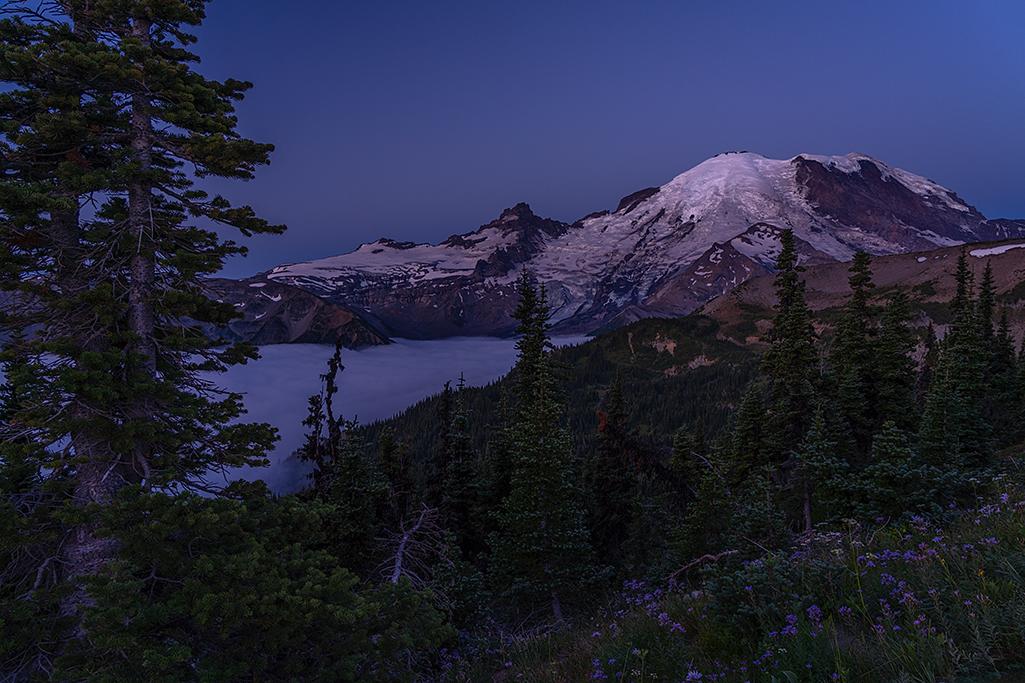
Morning blue hour over "The Mountain," Mount Rainier National Park / Rebecca Latson
My goal for the day was to hike the Fremont Mountain trail. You can reach the trailhead a variety of ways, including the route I took along the Sourdough Ridge trail to Frozen Lake. Stopping to adjust my pack, I noticed this awesome view of “The Mountain” and plunked down the tripod to capture a blue hour shot. Blue hour (which lasts more like 15-20 minutes) is that time pre-sunrise or après-sunset, when the landscape and sky are bathed in hues of blue, purple, mauve, and pink.
Since the camera was on a tripod, I used an aperture of f-9, ISO 160, and a shutter speed of ¼ second. The smaller aperture and ISO meant I’d experience less chance of noise in the image. The slightly slower shutter speed lightened things up a little. The sun was beginning to rise, touching first on Mount Rainier, but the blue hour colors remained long enough for this shot.
Sunrise At The Sunrise Area, Mount Rainier National Park (Washington State)

Sunrise at the Sunrise Area, Mount Rainier National Park / Rebecca Latson
I remained at this same spot after blue hour to capture sunrise. For blue hour and sunset/sunrise imagery, patience is key. You might think you’ve captured all you can in a composition, but sticking around a little longer, or arriving at a spot a little earlier, might allow you to photograph a series of beautiful shots in addition to sunrise or sunset.
Same ISO and aperture as the photo above with a slightly faster shutter speed (1/10 second).
Winter Sunlight And Shadows Over The Dunes, Great Sand Dunes National Park and Preserve (Colorado)
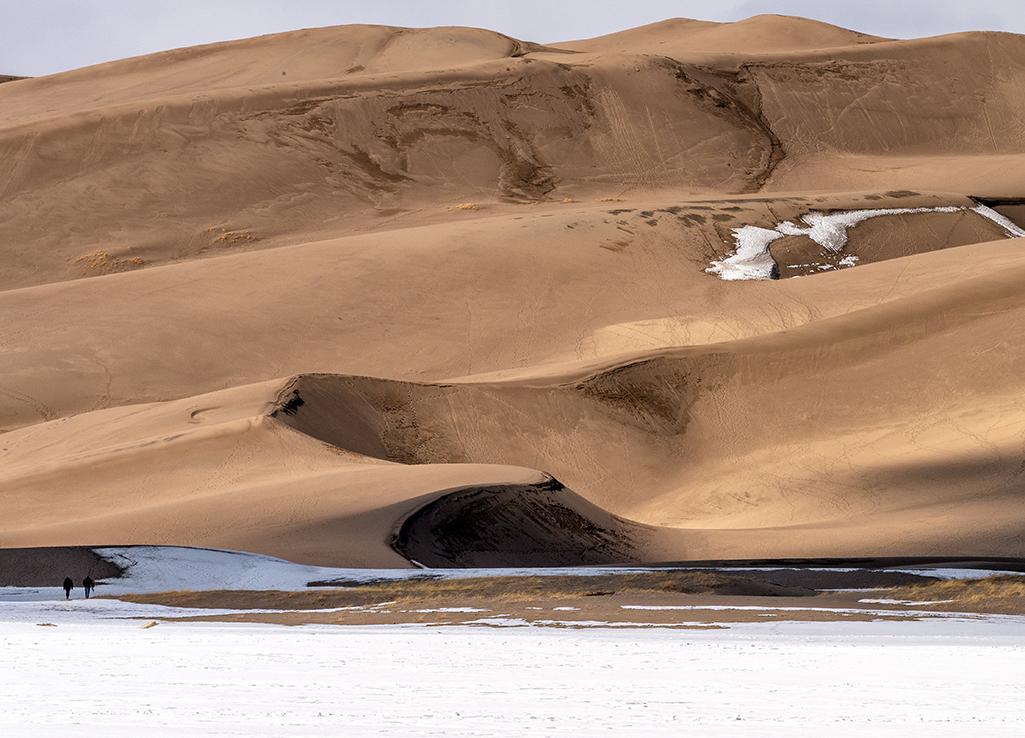
Winter sunlight and shadows over the dunes, Great Sand Dunes National Park and Preserve / Rebecca Latson
Sure, you’ve seen many website images of a sunrise or sunset over these tallest dunes in North America, with the Sangre de Cristo Mountains in the background. I have plenty of those shots. But have you ever really considered the scope and size of these sand dunes, all by themselves? I stood across the ½-mile-wide (0.8 km) expanse of snow-blanketed Medano Creek landscape with my camera and 24-105mm lens on a tripod. I deliberately zoomed in on the dunes, including those two people you see in the lower left portion of the composition. Those people, along with all the little footprints and a few sled treads on the sun-and-shadow-dappled giant dunes, really bring into focus the dunes’ size and scale. Sometimes you need the inclusion of humans and/or human-made objects to create that scale and reference for your viewer.
It was an exceptionally bright February day and I didn’t want to overexpose the snow or sky. I set the ISO to 160, aperture to f-10, and shutter speed to 1/360 to tone down the overall brilliance.
There you have it: my 11 favorite 2024 images. Always remember, photography is a subjective art, be it street, sport, or national park photography. What one person considers treasure, another may consider a waste of good memory space. All that really matters is whether you like the resulting images you capture with your own camera.
I have travel plans for this year. Whether they will pan out is anyone’s guess, but planning a national park trip is half the fun, don’t you think?
How about you? Any national park travel plans for 2025?




 Support Essential Coverage of Essential Places
Support Essential Coverage of Essential Places






